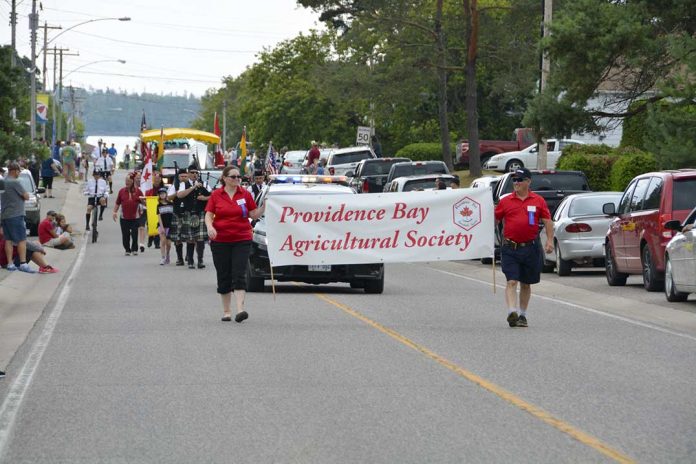Sheguiandah–Dawn Bazely first came to Manitoulin on an ecology field trip as a third-year undergraduate student at the University of Toronto in 1979. She was working on a cattail research project, measuring plant quadrats at the edge of a beaver pond, when she came face to face with an adult beaver. That was the moment she decided to be a field ecologist.
She went on to earn a masters and undergrad degree at the University of Toronto, in botany and biogeography, working in the field on Hudson Bay from 1980 to 1984. She completed a doctorate at Oxford University in the United Kingdom and returned to Canada to become a professor at York University in 1990.
Once at York, she was invited to prepare a field course. “It could be studying river dolphins up the Yangtse River in China or studying African ecology,” she said. “It could be scuba diving on coral reefs in Costa Rica or studying ornithology (birds) at Algonquin.”
Professor Bazely decided to locate her course on Manitoulin, at the Lake Huron Fisheries Research station at South Baymouth. “It was field methods in plant ecology,” she said. She was excited to display a recently rediscovered file folder that contained course notes, student papers, schedules, and her own handwritten plant list from that initial field course. There was even a copy of a letter she wrote in 1993 to the Rainbow County Tourism Association and cc’d to The Manitoulin Expositor about what they were doing. She ran that course from 1990 until 1993; the next year she had a baby.
She resurrected the field course this year. “Frankly, if you’d asked in 2019 or 2020 would I ever be resurrecting a field course like this, the answer would have been no,” she laughed.
“I don’t know why we are here,” she said. “I think it was being here last fall. I just needed to get out of Toronto. Manitoulin is such a healing place, I will say. I’ve loved it for about 40 years. It’s the place where I decided I wanted to have the career that I’ve had so I think in some way, I’m giving back to Manitoulin.”
Eight students participated in the course, which ran for two weeks from May 2-13. They came from York and other Ontario universities: Trent, Brock, Guelph, and Toronto Metropolitan (formerly known as Ryerson). They were based in Sheguiandah this time around, with accommodations at the Paradise Motel and a classroom and lab set up at Sheguiandah Hall.
Professor Bazely has been teaching a version of this field course virtually (with assistance from friend and colleague Dr. Shoshanah Jacobs from the University of Guelph), using science-at-home kits she developed, due to the pandemic. “York students were particularly affected,” she said. “Our demographic at York is recent immigrants, low income, multi-generational families working in distribution centres and factories, in jobs that were ruled as essential back in March 2020. They are highly racialized and were hit very hard by COVID. From the get-go, this was for kids in my classes.”
No one could step outside their house, she added. “You couldn’t even have a field course where students went on the street because lockdown was the boundaries of your property.”
Wondering where she could go in Ontario that was safe for a return to an in-person field course, she remembered Manitoulin Island and everything just came together. Professor Bazely emphasized how the community came together to make it happen. “The infrastructure that’s needed for these field courses is monstrous,” she said.
There were accommodations to figure out, meals, and access to areas for conducting field research. “You’ve got to find a place to set up your classroom, your lab,” she added. They couldn’t afford a bus due to having to keep costs down: most students had not worked in two years, so they needed to be somewhere they could easily walk to field locations. Sheguiandah Hall was accessible to the bay, Paradise Motel and Green Acres.
“I got the hall and more importantly, from an ecology perspective, this is part of the pre-Cambrian Shield,” noted Professor Bazely. “It is the only place on Manitoulin where the north shore crops up. The rest is escarpment, paleozoic, so I knew we had that cool geology.”
She brought in the traditional ecology course: identify the trees, learn about frogs, and she also brought in other scientists. Dr. Andrew Tanentzap, a leading researcher on microplastics, was one of those. He was Professor Bazely’s grad student and is now professor of global change and ecology and head of EcoSystems and Global Change Group at the University of Cambridge.
“He’s just had one of the most important research papers (on microplastics) published,” she said. “You’ve got one of the world’s trailblazing scientists right here on Manitoulin.”
Dr. Joe Shorthouse, retired entomologist from Laurentian University and occasional contributor to this paper, spent a day teaching the students about bugs and insects. Another associate led the students on a field trip to study turtles and frogs in their habitat.
There was a day spent with the Little Current Fish and Game Club and Manitoulin Streams at Bass Creek, and an Indigenous knowledge day where they visited the Ojibwe Cultural Foundation and Lillian’s in M’Chigeeng.
When this reporter visited the group at Sheguiandah Hall it was a hive of activity. Students were completing class work inside the hall and preparing gear for data collection at Sheguiandah Bay. Professor Bazely hustled between the student group and the car, getting students out the door and making sure equipment and lunches were all packed and loaded.
“These students haven’t been outside or done anything like this,” Professor Tanentzap pointed out. “They’re COVID children. This is the first time they’ve done any outdoor field work in their whole degree. They’re in their third (or fourth) year of university. It’s all been done through computer screens.”
Skye Vasey just completed his third year in environmental science/studies at Trent University. He came on the field trip because of the previous two years spent online. “It’s just been really hard to get field experience,” he said. He hopes he makes enough connections during the course of his undergrad to be able to find work on a study when he’s through.
Emily Whitehead was the youngest of the group. She’s entering her third year of biology at Toronto Metropolitan University and hopes to specialize in environmental science. She came on the field trip to obtain some hands-on experience. “I’ve done the lab stuff and the clinic stuff,” she said. “It’s just not for me. I wanted to try out the field experience and it’s been really great and has solidified that’s what I want to do.”
Most of the students are from the Greater Toronto area, Ms. Whitehead included. “It’s been nice seeing the environment and culture shift, coming to a place like Manitoulin. I think it’s a really important zone for environmental work.”
Several international students participated as well. Tama Chowdhury, from Bangladesh, is a fourth year York University student majoring in environmental science and specializing in life science. This was her first opportunity to explore another part of Ontario. “It’s really a nicer outlook to see, experience and be able to use the knowledge we’ve gained mostly from books and lectures,” she said. “It’s an opportunity to look towards the culture and (sense of) community and how everybody comes together when there’s an issue, for example at the hatchery.”
Nandini Patel is from India. She’s also a fourth-year student at York. She enrolled in this field course because she needed field experience for her degree, and to learn what she wants to do and what she is good at. “We have to know what are our drawbacks, where we are lacking, so this field course is pretty good,” she said. “I think it is difficult in the city to experience some things which we experienced here, like the unity and so much culture.”
“I think the story is you can be from anywhere in Canada and go on to be a professor at Cambridge University,” Professor Bazely said. “We’ve got what it takes. As long as we share that with students we can prepare them to be good citizens in the world, not just on the environmental but also on the social justice front.”





